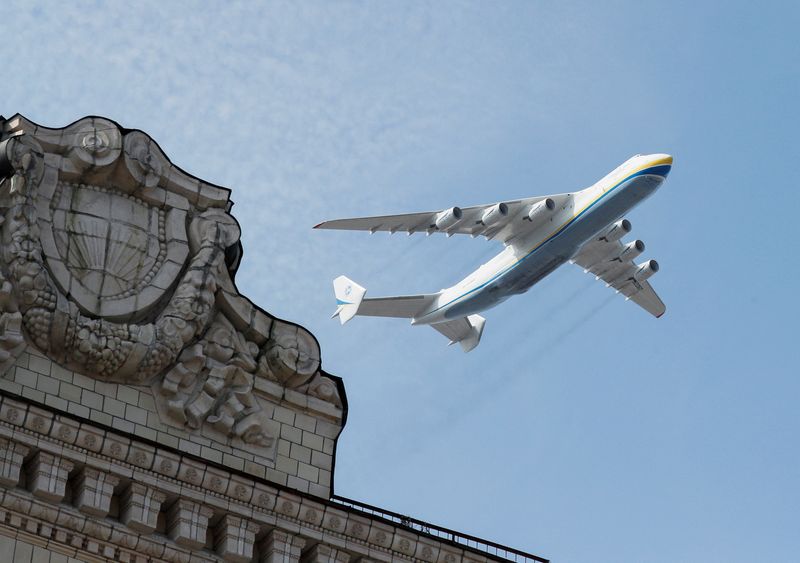By Joanna Plucinska, Valerie Insinna and Max Hunder
LONDON/KYIV (Reuters) - Ukraine's Antonov is expanding in drone making, a presentation by the country's umbrella defence group seen by Reuters shows, as it diversifies its core cargo plane business in response to Russia's invasion.
Drones made and adapted in Ukraine play a major part in the war and Antonov's previously unreported move is consistent with Ukraine's aim to be a global drone hub, boosted by investment in a sector that has grown dramatically since early 2022.
Antonov's new drone centre was opened "with the aim of enhancing unmanned systems manufacturing capabilities and providing support to private unmanned systems manufacturers in terms of expertise and services," the presentation by Ukroboronprom, which oversees Ukraine's defence sector, said.
It was made to officials in Washington, D.C., in June.
Antonov did not respond to requests for comment on the centre and expansion plans in the drone sector. A Ukroboronprom spokesperson declined to comment, citing security concerns.
Drone-making could now support legacy Soviet aerospace firms like Antonov that they have lost a major customer in Russia and suffered extensive damage from Russian attacks.
Under Ukroboronprom, Antonov has designed and built drones in the past, including the Horlytsia model, but cargo planes have long been its primary focus. In a symbolic blow, the An-225 Mriya, at the time the world's largest cargo plane and for which Antonov is best known, was destroyed early on in the war.
While cargo plane manufacturing will continue, the new drone centre could better serve Ukraine's war needs now and give Antonov's engineers more work, a person with knowledge of Antonov's plans told Reuters.
The individual could not be named because Antonov's drone plans are not yet publicly known.
Antonov's expertise in cargo planes could also be applied to long-distance drones, the source added, giving Ukraine's armed forces the capability to strike deeper into Russian territory.
Kyiv does not claim responsibility for attacking Russian soil, but experts and Western officials say it is behind intensifying drone incursions.
The new Antonov centre offers services including experimental aerodynamic studies, the creation of fully functional simulators for training Unmanned Aerial Vehicle (UAV) operators and developing component standards, according the presentation, which listed 26 functions.
LIVE TESTING
Kyiv has used aerial drones to attack airfields and Russian troops and aquatic drones against ships and a bridge. It also presents itself as a live battlefield testing ground for drone innovations by the world's defence suppliers.
Ukraine was mostly reliant on foreign UAVs after Russia began its invasion on Feb. 24, 2022, but is now able to produce a significant quantity of various types of drone following an intensive drive to support new manufacturers.
The proportion of domestic to foreign drones in Ukraine's arsenal is hard to estimate due to the high number of systems being used, their steep attrition rate, and wartime secrecy.
According to recent statements by senior officials, Ukraine has around 200 drone manufacturers and its armed forces have signed supply contracts for 30 new models of domestically produced drones.
However, most of these are start-ups founded after the invasion and operating at small scale, often lacking the production capacity and industry support needed to become significant players.
Ukrainian officials have said they want to capitalize on their Soviet-trained engineering talent to develop the post-war economy. That would include creating jobs in the drone industry.
A smaller-scale Ukrainian dronemaker visited by Reuters this year employs ex-Antonov engineers to make long-range drones.
The presentation coincides with a restructuring at Ukroboronprom aimed at attracting more customers and bolstering Ukraine's role in the international defence sector.
"The defence sector will be number one in Ukraine very soon," Ukraine's Strategic Industries Minister Oleksandr Kamyshin told Reuters, adding that drones were an essential part of aerospace industry investment.
"We have to focus on producing more weapons and ammunition locally," he added.

More broadly, Ukraine wants to invest more heavily in aircraft repair and construction, with Kamyshin saying giants like Antonov and others will probably "only grow".
However, the presentation also said Ukroboronprom intended to offload about 50% of its assets, which it described as "inefficiently utilized and unrelated to production".